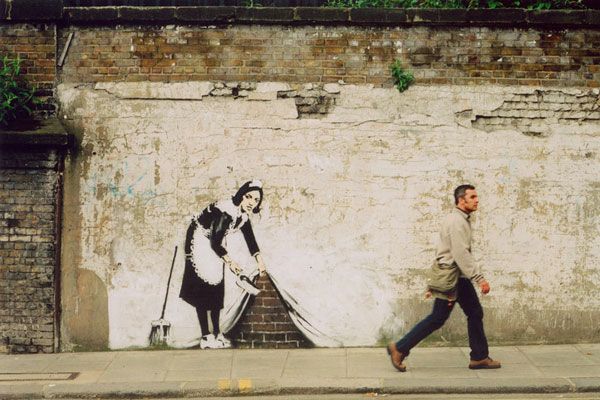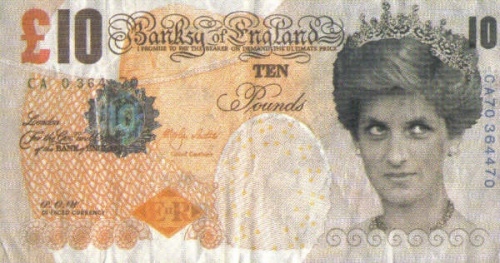Did You Know?
A Smooth Introduction to London Street Art and Artists
Being an arty person, I am attracted to all manner of artistic expression – the bolder and blunter the piece is, the more it catches my attention and admiration. This is very probably the reason I am so drawn to London street art, and especially to the style of Banksy – the most ubiquitous name in street art – whom I became familiar with a couple of years ago while visiting a friend in Bristol.
Banksy is one of the most mysterious fixtures in the industry, keeping his identity a secret to avoid arrest, covering his face with a hoodie even in interviews. Only those in his closest circle know him. He touches on a variety of topics, making satirical social and political commentaries, and often questioning authority in humorous and eye-opening ways. His work has been found on streets, walls, and bridges of cities throughout the world – Palestine, numerous cities in the U.S., and in the UK in London, Bristol, and Birmingham.
In 2005, Banksy chose the West Bank Wall, a 425-mile barrier that separates war-destroyed Palestine and Israel, and drew nine illustrations where liberty and wealth seemed only a dream. His aim? To present locals with the idea that freedom might be on the other side. Meanwhile, guards reportedly trained their guns on him from a distance, and a resident said, “We don’t want this wall to be beautiful. We hate it. Go home.”
Banksy’s art is a prime example of a classic controversy: vandalism vs. art. Art supporters praise his work. Some councils, like Bristol and Islington, have even officially protected it, while officials in other areas have removed it.
Are you able to identify the stunt element on this piece?
What is Lady Di’s face doing on a 10 pound note? In 2004, Banksy printed one million pounds worth of his “Di Faced Tenner,” on which the face of Princess Di replaces that of the Queen. The altered bills, which also feature the words “Banksy of America,” were dropped into a crowd at the 2004 Notting Hill Carnival and, later that year, The Reading Festival. This led to the works being misused as actual payment in London, as some deluded festival goers used it to pay for their pints.
There aren’t many cities in the world that don’t have graffiti, and often the most intrepid and famous artists travel around and leave their mark in multiple places. To get familiar with graffiti and overall street art, I focused my attention on East London – Bricklane, Shoreditch, and Spitalfield.
For different reasons, this area has always been a center of attention. In the 19th century, it was the territory of gruesome serial killer Jack the Ripper. In 1902, when Jack London moved to England’s capital and chose to live in the area, he described how 55% of children born in East London didn’t make it past 5 years old. In the 20th century – even 20-30 years ago – the Spitalfield and Shoreditch areas were almost the dodgiest part of the city; people had to be paid to walk around the streets. Now it’s the center for fashion, music, and street art, and people are desperate to live there, including actress Keira Knightley, who only recently relocated out of the area.
How did East London turn itself around in the last 20 years? In the early 1990s, young student artists started renting out the multitude of low-rise warehouses in Shoreditch, which were originally built to accommodate London’s furniture industry but were left abandoned by the middle of the 20th century following the industry’s decline, and had been converted into creative studios. The innovators’ initial success drew more artists to the area, and some galleries were backed financially by the wealthier companies from nearby London proper in exchange for creative services.
But what inspired the street artists to work here?
As an anthropologist from Birkbeck, University of London said: “…an absence of control creates a form of ‘seepage’ that allows people to manipulate public space in various ways, allowing for a greater variety of self-expression than in tightly regulated spaces. Graffiti and ‘street art’ are examples of this tendency and transgression in an urban context.”
Not only had the lack of police control allowed the graffiti artists to operate during the night, but the nature of the area encouraged urban exploration as well. Shoreditch is shoddy and, despite the wealth, activity, and creativity, comprises a variety of abandoned buildings, railway lines, and wasteland car parks, upon which artists feel more relaxed to display their work. Moreover, it is the perfect place for those artists who struggle to find a way of getting their work in galleries, and their artistic expression isn’t restricted by a limited space. Soon, not only the artists but also the businesses in Shoreditch began benefitting from showing and commissioning art on the outside of their buildings.
All of these factors contributed to London’s East End area becoming an open-air museum for street artists, some of whom are residents in London. The vast majority of the artists in the area, though, are travellers who stay for a while and then continue on their journey, leaving masterpieces along the way. In addition to Banksy, some other well-known graffiti artists are: King Robbo (UK), Invader (France), C215 (France), Citizen Kane (UK), Conor Harrington (Ireland), Shephard Fairey (USA), Jimmy C. (Australia), Roa (Belgium), Rondo (Venezuela), Bastardilla (Colombia), Alexis Diaz (Puerto Rico), Paul Don Smith (UK), Ronzo (UK), Code FC (UK), Ben Eine (UK), D*Face (UK), Pablo Delgado (Mexico), Stik (UK), and Clett Abraham (France), among others. Next week, we’ll explore a few of these big names in street art.
Banksy’s Di-faced Tenner
Related Articles

2024 Teacher Appreciation Week Winner Review | Our Life-Changing Trip to Rome!
Eighth grade math teacher Mr. Brandon Johnson was our 2024 Teacher Appreciation Week Giveaway winner! WorldStrides gifted him along with his son, brother, and nephew, a roundtrip ticket to Rome! They ...

Around the World in 10 Holiday Cookies
The holiday season is here, and we’ve got one thing on our mind: cookies! Frosted, sugar-dusted, or jelly-filled, the season wouldn’t be the same without these little morsels of delight. With our ...

The 2024 WorldStrides Student Photo & Video Contest Gallery
As we wrap up this year’s contest, we want to thank every student who participated! We had some incredible submissions and we’re thrilled to share them all with you. From shots of ancient ...

Girl Scouts: Costa Rica Tour
Explorica by WorldStrides is a dedicated leader in experiential travel providing itineraries full of authentic and interactive learning experiences. When it comes to Girl Scouts, we work one-on-one wi...



